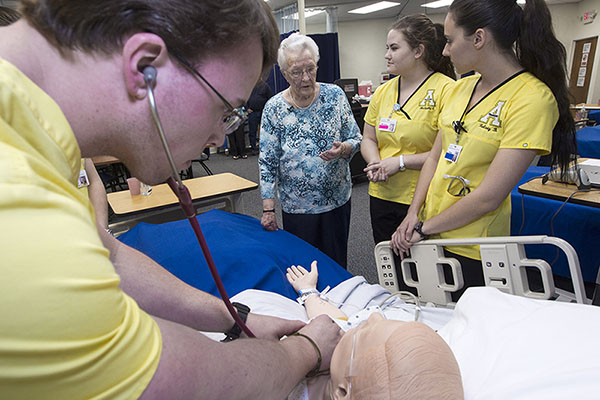Nurse Mary S. Shook talks about her 40-year career healing and nurturing Appalachian State University students. She was the founding member of the Student Health Association of North Carolina. Appalachian’s M.S. Shook Health Service on campus – which handles 45,000 student visits each year – is named for her.
Generations of Appalachian students received care from this founding member of the Student Health Association of North Carolina. The university's M.S. Shook Health Service is named for her.
About Appalachian State University
As a premier public institution, Appalachian State University prepares students to lead purposeful lives. App State is one of 17 campuses in the University of North Carolina System, with a national reputation for innovative teaching and opening access to a high-quality, cost-effective education. The university enrolls more than 21,000 students, has a low student-to-faculty ratio and offers more than 150 undergraduate and 80 graduate majors at its Boone and Hickory campuses and through App State Online. Learn more at https://www.appstate.edu.
Transcript
Mary Shook: My name is Mary Stevenson Shook and I was the first nurse at Appalachian State Teachers College. Appalachian had never had a budget set up for medicine of any kind. Walked into the basement with the heating pipes and the water pipes. I had two rooms, you walked into two rooms connected by a half bath. No closets, no nothing and that was all. I didn’t have anything. So I went up to the drug store and bought me a thermometer and some aspirin and some cough syrup, and that’s what I started with. An administrator kept telling me that I would have a place on the campus sometime, he promised me that. I worked anywhere from that hall that I started off in, to what was once the nursing home and then I went into the basement of a dormitory and worked in there, and finally ended up in the building that we’re in now. Making decisions of what to do with sick students was my main concern. I remember dealing with the polio situation. It was no fun. It wasn’t as bad as it was in a lot of places. They tried to prevent spreading it by keeping it all in one place, but that was before we had vaccine. They converted a hotel, I think, in Hickory for this area. We would take turns about sending nurses from hospitals and health departments. Take days off and go work for polio. Same way with flu shots. We had 4,000 students and we had three-fourths of the students in bed at the same time and sick. One nurse volunteered to stay in the office, in my office, and she took the boy’s dorms and I took the girl’s dorms. We would start at 7 o’clock in the morning and work all day, taking temperatures and what not. We took care of them the best way we could. Home sicknesses is a disease and certainly for the first semester. The boys were just coming back from service at that time and we had a lot of students within a 50-mile radius that was homesick. I took many of them home with me overnight. Just sort of be mama to them until they got ready to go bed, make them comfortable, gave them a good night's sleep, wake ’em up, give them breakfast and take them back to school.
MS: When I first came they had a trainer for the football team, but on Monday morning I had football clinic. Dressings, ultrasounds and such as the like to do, until we finally ended up with a full-time physician. He took over the football field, and that was in 1965. We got along, I don’t know how, but we did. When I had time, trying to do something about a student health service that was more important than anything else because at that time the larger schools in the state had student health services that were financed and everything. And we were just building. And I learned from going to meetings with other schools like Wake Forest, Duke, Clemson. Every time I’d go to a meeting, I’d bring an idea back and try to do something about it on the campus. That was the beginning of our student health service, that was the way it was set up. When we went into the student health building, not a single building, but one floor of a building in 1982...and I retired in ’83. When I had learned that they named the infirmary after me, I didn’t know they had dedicated it. I was just...shocked, but thrilled. I couldn’t help but think about the hours that had gone into getting it to where it was because there was many hours in it. I had worked as far as I could, not being a doctor, to bring the standard to student health up to par. It was good. It really was, to walk into it the first time. To have an office of my own, never had an office of my own and wasn’t connected to somebody else...and I was proud.
MS: (Reading) “For one whose sympathy, understanding and loving counsel has endeared her to all who knew her and has made her such a vital part of life on our campus. And for one whose friendship has meant so much to all of us. We, the staff of the 1955 Rhododendron, do dedicate the volume to one whom we respect so highly and love so dearly, Mrs. Shook.”
What do you think?
Share your feedback on this story.












